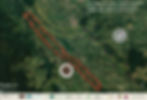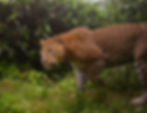CORRIDORS FOR CONSERVATION
2024 UPDATE
Elbedda Ridge
Our 2024 monitoring of the Elbedda Ridge Corridor consisted of 8 remote camera stations along the >9km ridgeline. Among 250 leopard sightings, 17 individual leopards were identified, 5 of which were transients.
ERC’s connection to Horton Plains National Park, the most protected area, might be a reason for ERC’s active leopard population, proving how multiple wild spaces being interlinked contribute towards a healthy population.
From the 6 adult females identified; Batty, Inga and Portia were seen with cubs born between late 2023 and mid-2024. Interestingly, the lower areas of the ERC are also home to breeding leopards, in contrast to the PRFC in which resident leopards chose higher ridgelines as refuges. This discovery highlights the importance of conserving various landscapes, to allow space for sustained viable leopard populations.

Nino and Ozzie were the most monitored of the resident males. With Nino being born in PRFC during 2019, then gradually moving to settle in ERC, and Ozzie circulating from PRFC to Western Ridge to ERC across 8 years.
Ozzie was tragically captured in a snare and killed in December 2024. Horrifically, in addition to his death, a post mortem dismemberment had been carried out signaling some ominous perpetrators at large. Ozzie’s majestic presence across these mixed estate lands will be remembered as he has taught us much about leopard tenure in this landscape.
Following Ozzie’s death, his range was quickly taken over by two other adult males, signalling the continuation of occupancy, a natural occurrence amongst leopards.

Peak Ridge Forest Corridor
In 2024 we were able to significantly increase our monitoring from the previous year with 13 remote camera locations active for almost 2500 days.
There were a total of 24 individual leopards detected in PRFC during this year. This is more than double the number from 2023.
Of these 24 individuals, 7 were categorized as transient animals moving through the landscape. One of these 7 however, was a previously resident male “Newton” who had been on the southeastern section of the PRFC for over 3 years, and disappeared from the area at the beginning of the year.

This vacancy, as seen before, resulted in other adult males quickly entering the area. Adult male Wedge was photo-captured 20 times in 2024 signalling his taking over as resident.

Peradeniya and Surrounds
Peradeniya is the northern terminus area of the envisioned “Corridors for Conservation” linkages. We have previously conducted research in the Dunumadallawa forest reserve within Kandy city limits, which marks the effective northern terminus.
Monitoring is south from there along the ridgelines, but including surveys of the non-ridge habitats, through Peradeniya university lands, Galaha, Deltota, down to Pidurutalagala Conservation Forest.
By the end of the year we had expanded beyond University lands to include 4 private lands to the south. From August to December 2024 we set up 8 remote camera stations in this landscape. As expected in this challenging environment, the RAI of leopards is low (< 2.0), with 5 individual leopards identified thus far.

Other wild cats and mammalian wildlife are also being detected on these mixed landscapes.
2023 UPDATE
Elbedda Ridge
On April 17th, 2023, WWCT signed a Memorandum of Understanding with the Kelani Valley Plantations PLC (KVP) to preserve an approximately 9.5 km long strip of land–the second of the Corridors for Conservation. This corridor, running along Elbedda Ridge connects the Agra-Bopats Forest Reserve to Elbedda forest. This ridgeline is even higher than the PRFC and features wet zone montane forest sloping up from the lower slopes covered in tea.
2022 monitoring previously revealed Elbedda Ridge’s photo-capturing occasions to exceed those of the PRFC and Western Ridge, indicating the importance of this area for leopard vitality. Further monitoring in 2023 revealed mating of leopards and new cubs, indicating a healthy population.
Peak Ridge Forest Corridor
In the Peak Ridge Forest Corridor (PRFC), leopard monitoring days increased and the relative abundance of leopards remained consistent with past years–about 7.81 per month. This high land use by leopards indicates the area’s value, as leopards are a cornerstone of these ecosystems.

“Arnold” was WWCT’s most frequently monitored leopard in PRFC since 2016, but he unexpectedly disappeared from PRFC in 2021. Throughout 2022 he was not photo-captured and he was assumed to have died or shifted his range to an unmonitored area. Within a month of his disappearance, two new males known as ”Norman” and “Newton” appeared at a camera station that Arnold had once frequented. The rapid filling of the vaccum left by Arnold shines a light on the communication networks of a species often thought of as solitary. In 2023, however, Arnold was found during the monitoring of an estate on the edge of Peak Wilderness, reclaiming his spot as the longest monitored leopard.

Habitat restoration
Habitat restoration and reforestation have been more successful in 2023. In 2022, the replanted saplings faced a high mortality rate. But, 997 saplings were obtained, along with 2000 seeds, and they were given more time to grow to combat this. By 2023, higher precipitation allowed saplings to flourish and grow, enabling planting in November. 450 new saplings have now been acquired to use in the next generation of new sites.

Human impact
Snares have increased due to the economic crisis, when protecting crops from wildlife was more valuable to plantations than ever. WWCT and the Department of Wildlife Conservation have pushed awareness and patrolling for snares more in the past year, having removed 12 snares from the PRFC in 2022. The number of snares in this area seems to have increased, likely due to the economic crisis. Many photo-captured animals bear scars from snares.
INTRODUCTION & BACKGROUND
The Corridors for Conservation (CC) initiative is the outcome of years of research by the WWCT team, research which began in 2016.
The death of 10 leopards in Sri Lanka’s southern Central Highlands, that had been caught in snares set for capture of other wildlife, but that had indiscriminately killed leopards, brought to our attention the need for understanding leopard land use and movement in this tea dominated highland landscape.
Having been provided a research base by Resplendent Ceylon-Tea Trails, on one of their tea estates, we expanded and continued with the research.
Our focus shifted to investigating the leopards within, as well as above, the tea plantation landscape. And so the story of 'Above the Tea where the leopard still roams' evolved into 'Amidst the tea where the leopard still roams ' as we started unraveling the mystery of the Highland leopard.
These Corridors for Conservation are the product of this research and a landscape level conservation solution to protecting these mixed use lands in Sri Lanka’s biodiverse Central Highlands.
The identification of these leopard centric Conservation Corridors was the result of this continued research across this mixed forest, tea and other plantation (pinus, eucalyptus) landscape.
Our remote cameras picked up leopards throughout the landscape, with almost all of them detecting repeated presence of leopards. The males more wide spread, using the tea to move through, accessing forest patches, while the females almost exclusively chose to reside within the higher ridges.
It is this data that informs the selection of these corridors, the leopards themselves telling us where we should concentrate the protection of these remnant forest lands.
As such these Corridors are upland linear ridge lands, that hold the remnant patches of montane forests, spectacular forests that once cloaked these mountains, before the onset of coffee and now tea plantations.
Over the centuries of change, wildlife including these leopards, have learnt to navigate these highlands, fitting in their homes where ever they can.






